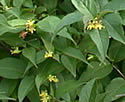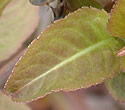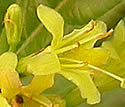Diervilla lonicera (Bush Honeysuckle)
| Also known as: | Dwarf Bush Honeysuckle, Northern Honeysuckle, |
|---|---|
| Genus: | Diervilla |
| Family: | Diervillaceae (Bush Honeysuckle) |
| Life cycle: | perennial woody |
| Origin: | native |
| Habitat: | part shade, shade; average to dry sandy or rocky soil; woods, woodland edges, clearings, thickets, bluffs, along railroads |
| Bloom season: | June - July |
| Plant height: | 1 to 3 feet |
| Wetland Indicator Status: | none |
| MN county distribution (click map to enlarge): |  |
| National distribution (click map to enlarge): |  |
Pick an image for a larger view. See the glossary for icon descriptions.
Detailed Information
Flower: 


![[photo of flowers]](/udata/r9ndp23q/pd3/diervilla-lonicera-43798-1-t.jpg) Clusters of 2 to 7 short-stalked flowers at the tips of 1-year-old branches and arising from leaf axils near the branch tips. Flowers are funnel-shaped, ½ to ¾ inch long, hairy on the inner surface especially inside the tube, and with 5 narrow, spreading lobes, one of which typically is somewhat larger and has a darker coloring than the rest. In the center are 5 densely hairy stamens with yellow tips and a long, slender, green style with a dome-shaped stigma at the tip.
Clusters of 2 to 7 short-stalked flowers at the tips of 1-year-old branches and arising from leaf axils near the branch tips. Flowers are funnel-shaped, ½ to ¾ inch long, hairy on the inner surface especially inside the tube, and with 5 narrow, spreading lobes, one of which typically is somewhat larger and has a darker coloring than the rest. In the center are 5 densely hairy stamens with yellow tips and a long, slender, green style with a dome-shaped stigma at the tip.
![[photo of reddish flowers]](/udata/r9ndp23q/pd3/diervilla-lonicera-003-t.jpg) Flower color is initially pale yellow or even greenish yellow, becoming orange to red with age. The 5 sepals surrounding the base of the flower are narrowly triangular and about as long as the floral tube. The ovary sits between the stalk and flower.
Flower color is initially pale yellow or even greenish yellow, becoming orange to red with age. The 5 sepals surrounding the base of the flower are narrowly triangular and about as long as the floral tube. The ovary sits between the stalk and flower.
Leaves and stems: 

![[photo of leaves]](/udata/r9ndp23q/pd3/diervilla-lonicera-43798-t.jpg) Leaves are 2 to 5 inches long, 1 to 2¾ inches wide, lance-elliptic to egg-shaped with a rounded or tapered base, a long taper to the pointed tip, and a short stalk. Edges are finely toothed and finely hairy, surfaces are mostly hairless except sometimes along the midvein. The upper surface is dark green, the lower paler, and leaves may be tinged a bronzy color across the surface or around the edges, especially when young.
Leaves are 2 to 5 inches long, 1 to 2¾ inches wide, lance-elliptic to egg-shaped with a rounded or tapered base, a long taper to the pointed tip, and a short stalk. Edges are finely toothed and finely hairy, surfaces are mostly hairless except sometimes along the midvein. The upper surface is dark green, the lower paler, and leaves may be tinged a bronzy color across the surface or around the edges, especially when young.
![[photo of bud]](/udata/r9ndp23q/pd3/diervilla-lonicera-bud-02-t.jpg) Twigs are green or reddish brown, hairless or minutely hairy in lines. Older bark is brown to gray, becoming hairless. Plants sucker from spreading rhizomes, often forming colonies.
Twigs are green or reddish brown, hairless or minutely hairy in lines. Older bark is brown to gray, becoming hairless. Plants sucker from spreading rhizomes, often forming colonies.
Fruit: 
![[photo of developing fruit]](/udata/r9ndp23q/pd3/diervilla-lonicera-07-2-t.jpg) The persistent sepals spread out as fruit develops, capping the fruit forming below. Fruit is a 2-valved capsule 1/3 to ½ inch long, green to brown, oblong-elliptic to narrowly egg-shaped. Plants are self-sterile, requiring pollination from a different plant that is not a clone.
The persistent sepals spread out as fruit develops, capping the fruit forming below. Fruit is a 2-valved capsule 1/3 to ½ inch long, green to brown, oblong-elliptic to narrowly egg-shaped. Plants are self-sterile, requiring pollination from a different plant that is not a clone.
![[photo of capsules in winter]](/udata/r9ndp23q/trees/diervilla-lonicera-dwarf-bush-honeysuckle_0327_120719-t.jpg) The capsules persist through winter.
The capsules persist through winter.
![[photo of seeds]](/udata/r9ndp23q/pd3/diervilla-lonicera-0327133659pmax-t.jpg) Seeds are less than .5mm long, golden brown with a textured surface.
Seeds are less than .5mm long, golden brown with a textured surface.
Notes:
Formerly in the Caprifoliaceae (Honeysuckle) family, this species gets its “honeysuckle” common name and lonicera species epithet from the shape of its flowers, which resemble those of true honeysuckles (Lonicera species), but that's where the similarities end. Bush Honeysuckle has serrated leaves and the fruit is a capsule, where true honeysuckles have toothless leaves and berries for fruit.
Native Plant Nurseries, Restoration and Landscaping Services ↓
More photos
 Bush Honeysuckle plants
Bush Honeysuckle plants Bush Honeysuckle plants
Bush Honeysuckle plants bronzy leaves emerging in spring
bronzy leaves emerging in spring more flowers, and bronze-tinged leaves
more flowers, and bronze-tinged leaves
Photos by K. Chayka taken in a private garden in Ramsey County. Photos courtesy Peter M. Dziuk taken in northeastern Minnesota.
Comments
Have you seen this plant in Minnesota, or have any other comments about it?
on: 2015-06-10 20:55:24
Saw this plant flowering in abundance at Battle Creek Regional Park, east side.
on: 2016-06-05 12:10:38
There is nothing about the pink Honeysuckle in this site. If you find the yellow you normally find the pink.
on: 2016-06-06 11:47:38
The pink honeysuckles are European or Asian species that are sold in the nursery trade and escape cultivation.
on: 2018-05-15 21:10:12
Is this invasive?
on: 2018-05-15 21:36:16
The native honeysuckles are not invasive.
on: 2018-06-22 17:01:42
This grows wild in numerous spots in the Brainerd area and it is expanding in my yard. A nice native plant for dry shady areas.
on: 2018-07-07 18:04:30
Fairly frequent in semi-shaded areas by Lake Burntside.
on: 2018-08-06 14:08:20
There is a bush, about 3' tall in the boarder next to my house. Previous owners must have planted it. It has sprouted outside the boarder. Trying to remove the grow in the grass but keep the plant within it's boarder. The bees love it!
on: 2018-08-21 10:56:15
My newly planted (1 year) Bush Honeysuckle (Diervilla lonicera, I think) has developed very long branches. I can't fine any information on if and how to prune this shrub to stay in the area planted.
on: 2018-09-25 06:51:38
This plant is abundant throughout Split Rock Lighthouse State Park.
on: 2022-08-12 01:27:56
A previous owner of my house must have planted this plant, but I'm very happy they did! Many different bees, wasps, and flies love the yellow flowers - a ton of pollinators visit it when it's in bloom. It also flowers for a relatively long time I think.
on: 2022-09-24 12:18:53
I've seen large numbers of these around Duluth. This is another plant that I didn't suspect was a Honeysuckle. (They seemed too short, among other things). There are many growing on the West side of Swan Lake Rd. near Hugo Ave. There are also some growing along the runoff pond a little further south on the other side of the street.
on: 2023-06-18 21:02:46
It is abundant along my driveway and in my yard.






